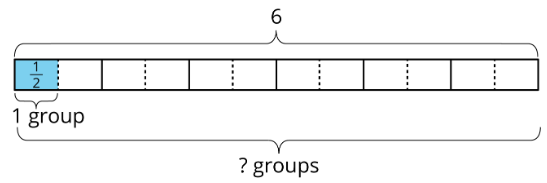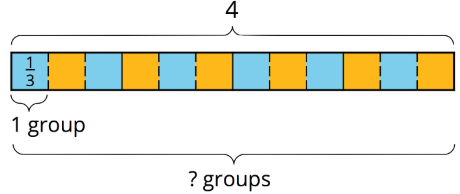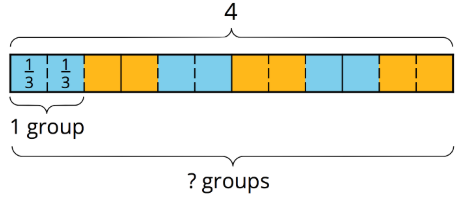23.1: Dividing by Unit and Non-Unit Fractions
- Page ID
- 40247
Lesson
Let's look for patterns when we divide by a fraction.
Exercise \(\PageIndex{1}\): Dividing by a Whole Number
Work with a partner. One person solves the problems labeled “Partner A” and the other person solves those labeled “Partner B.” Write an equation for each question. If you get stuck, consider drawing a diagram.
- Partner A:
How many 3s are in 12?
Division equation:

How many 4s are in 12?
Division equation:

How many 6s are in 12?
Division equation:

Partner B:
What is 12 groups of \(\frac{1}{3}\)?
Multiplication equation:

What is 12 groups of \(\frac{1}{4}\)?
Multiplication equation:

What is 12 groups of \(\frac{1}{6}\)?
Multiplication equation:

- What do you notice about the diagrams and equations? Discuss with your partner.
- Complete this sentence based on what you noticed:
Dividing by a whole number \(a\) produces the same result as multiplying by ________.
Exercise \(\PageIndex{2}\): Dividing by Unit Fractions
To find the value of \(6\div\frac{1}{2}\), Elena thought, “How many \(\frac{1}{2}\)s are in 6?” and then she drew this tape diagram. It shows 6 ones, with each one partitioned into 2 equal pieces.
\(6\div\frac{1}{2}\)

- For each division expression, complete the diagram using the same method as Elena. Then, find the value of the expression.
- \(6\div\frac{1}{3}\)

Value of the expression: ____________
- \(6\div\frac{1}{4}\)

Value of the expression: ____________
- \(6\div\frac{1}{6}\)

Value of the expression: ____________
- Examine the expressions and answers more closely. Look for a pattern. How could you find how many halves, thirds, fourths, or sixths were in 6 without counting all of them? Explain your reasoning.
- Use the pattern you noticed to find the values of these expressions. If you get stuck, consider drawing a diagram.
- \(6\div\frac{1}{8}\)
- \(6\div\frac{1}{10}\)
- \(6\div\frac{1}{25}\)
- \(6\div\frac{1}{b}\)
- Find the value of each expression.
- \(8\div\frac{1}{4}\)
- \(12\div\frac{1}{5}\)
- \(a\div\frac{1}{2}\)
- \(a\div\frac{1}{b}\)
Exercise \(\PageIndex{3}\): Dividing by Non-unit Fractions
- To find the value of \(6\div\frac{2}{3}\), Elena started by drawing a diagram the same way she did for \(6\div\frac{1}{3}\).

- Complete the diagram to show how many \(\frac{2}{3}\)s are in 6.
- Elena says, “To find \(6\div\frac{2}{3}\), I can just take the value of \(6\div\frac{1}{3}\) and then either multiply it by \(\frac{1}{2}\) or divide it by 2.” Do you agree with her? Explain your reasoning.
- For each division expression, complete the diagram using the same method as Elena. Then, find the value of the expression. Think about how you could find that value without counting all the pieces in your diagram.
- \(6\div\frac{3}{4}\)

Value of the expression:___________
- \(6\div\frac{4}{3}\)

Value of the expression:___________
- \(6\div\frac{4}{6}\)

Value of the expression:___________
- Elena examined her diagrams and noticed that she always took the same two steps to show division by a fraction on a tape diagram. She said:
“My first step was to divide each 1 whole into as many parts as the number in the denominator. So if the expression is \(6\div\frac{3}{4}\), I would break each 1 whole into 4 parts. Now I have 4 times as many parts.
My second step was to put a certain number of those parts into one group, and that number is the numerator of the divisor. So if the fraction is \(\frac{3}{4}\), I would put 3 of the \(\frac{1}{4}\)s into one group. Then I could tell how many \(\frac{3}{4}\)s are in 6.”
Which expression represents how many \(\frac{3}{4}\)s Elena would have after these two steps? Be prepared to explain your reasoning.
- \(6\div 4\cdot 3\)
- \(6\div 4\div 3\)
- \(6\cdot 4\div 3\)
- \(6\cdot 4\cdot 3\)
- Use the pattern Elena noticed to find the values of these expressions. If you get stuck, consider drawing a diagram.
- \(6\div\frac{2}{7}\)
- \(6\div\frac{3}{10}\)
- \(6\div\frac{6}{25}\)
Are you ready for more?
Find the missing value.

Summary
To answer the question “How many \(\frac{1}{3}\)s are in 4?” or “What is \(4\div\frac{1}{3}\)?”, we can reason that there are 3 thirds in 1, so there are \((4\cdot 3)\) thirds in 4.
In other words, dividing 4 by \(\frac{1}{3}\) has the same result as multiplying 4 by 3.

\(4\div\frac{1}{3}=4\cdot 3\)
In general, dividing a number by a unit fraction \(\frac{1}{b}\) is the same as multiplying the number by \(b\), which is the reciprocal of \(\frac{1}{b}\).
How can we reason about \(4\div\frac{2}{3}\)?
We already know that there are \((4\cdot 3)\) or 12 groups of \(\frac{1}{3}\)s in 4. To find how many \(\frac{2}{3}\)s are in 4, we need to put together every 2 of the \(\frac{1}{3}\)s into a group. Doing this results in half as many groups, which is 6 groups. In other words:

\(4\div\frac{2}{3}=(4\cdot 3)\div 2\)
or
\(4\div\frac{2}{3}=(4\cdot 3)\cdot\frac{1}{2}\)
In general, dividing a number by \(\frac{a}{b}\), is the same as multiplying the number by \(b\) and then dividing by \(a\), or multiplying the number by \(b\) and then by \(\frac{1}{a}\).
Glossary Entries
Definition: Reciprocal
Dividing 1 by a number gives the reciprocal of that number. For example, the reciprocal of \(12\) is \(\frac{1}{12}\), and the reciprocal of \(\frac{2}{5}\) is \(\frac{5}{2}\).
Practice
Exercise \(\PageIndex{4}\)
Priya is sharing 24 apples equally with some friends. She uses division to determine how many people can have a share if each person gets a particular number of apples. For example, \(24\div 4=6\) means that if each person gets 4 apples, then 6 people can have apples. Here are some other calculations:
\(24\div 4=6\qquad 24\div 2=12\qquad 24\div 1=24\qquad 24\div\frac{1}{2}=?\)
- Priya thinks the “?” represents a number less than 24. Do you agree? Explain or show your reasoning.
- In the case of \(24\div\frac{1}{2}=?\), how many people can have apples?
Exercise \(\PageIndex{5}\)
Here is a centimeter ruler.
- Use the ruler to find \(1\div\frac{1}{10}\) and \(4\div\frac{1}{10}\).
- What calculation did you do each time?
- Use this pattern to find \(18\div\frac{1}{10}\).
- Explain how you could find \(4\div\frac{2}{10}\) and \(4\div\frac{8}{10}\).

Exercise \(\PageIndex{6}\)
Find each quotient.
- \(5\div\frac{1}{10}\)
- \(5\div\frac{3}{10}\)
- \(5\div\frac{9}{10}\)
Exercise \(\PageIndex{7}\)
Use the fact that \(2\frac{1}{2}\div\frac{1}{8}=20\) to find \(2\frac{1}{2}\div\frac{5}{8}\). Explain or show your reasoning.
Exercise \(\PageIndex{8}\)
Consider the problem: It takes one week for a crew of workers to pave \(\frac{3}{5}\) kilometer of a road. At that rate, how long will it take to pave 1 kilometer?
Write a multiplication equation and a division equation to represent the question. Then find the answer and show your reasoning.
(From Unit 4.2.6)
Exercise \(\PageIndex{9}\)
A box contains \(1\frac{3}{4}\) pounds of pancake mix. Jada used \(\frac{7}{8}\) pound for a recipe. What fraction of the pancake mix in the box did she use? Explain or show your reasoning. Draw a diagram, if needed.
(From Unit 4.2.4)
Exercise \(\PageIndex{10}\)
Calculate each percentage mentally.
- \(25\)% of \(400\)
- \(50\)% of \(90\)
- \(75\)% of \(200\)
- \(10\)% of \(8,000\)
- \(5\)% of \(20\)
(From Unit 3.4.4)

